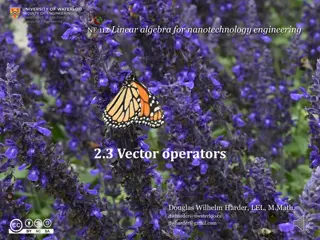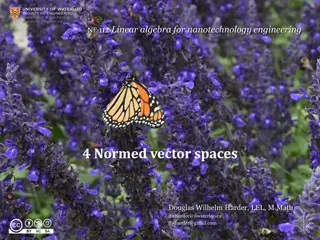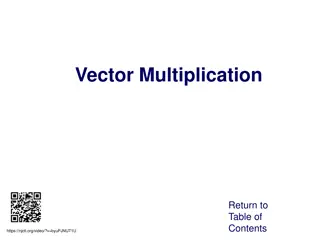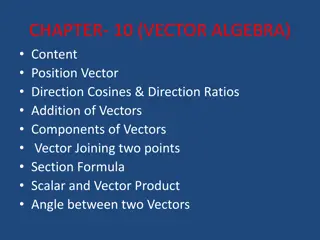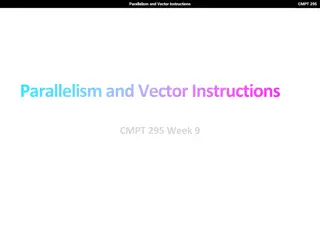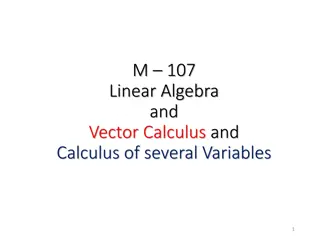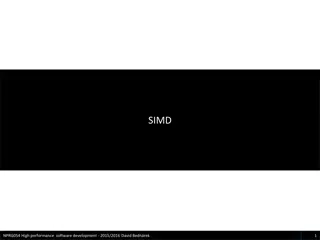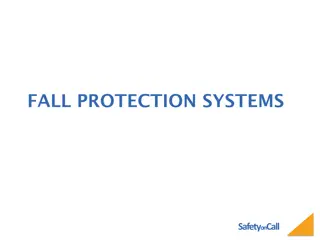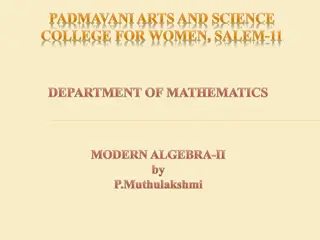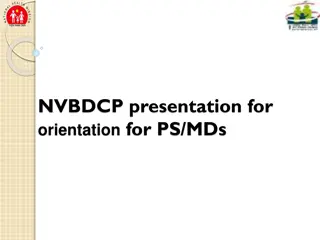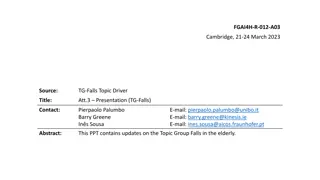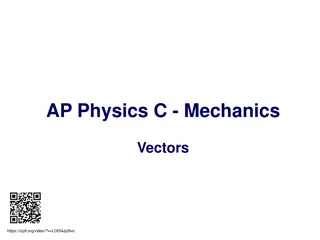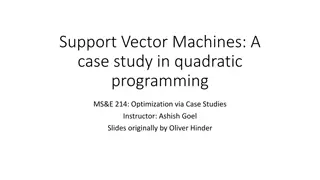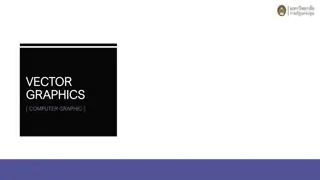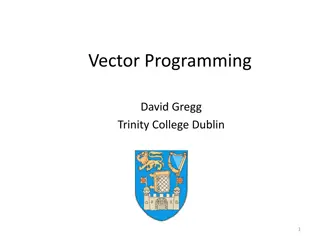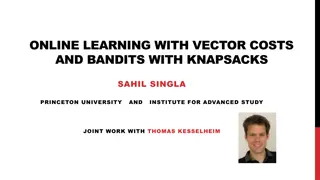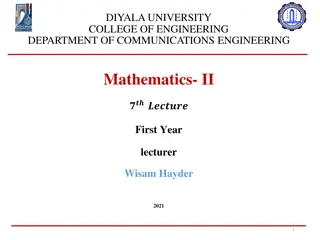
Understanding Support Vector Machines for Classification and Regression
Explore the fundamentals of Support Vector Machines (SVM), a supervised learning technique that creates decision boundaries to separate data points into distinct sets. Learn about SVM basics, hyperplanes, maximum-margin classifiers, support vectors, creating the maximum margin hyperplane, and support vector classifiers in this comprehensive guide.
Download Presentation

Please find below an Image/Link to download the presentation.
The content on the website is provided AS IS for your information and personal use only. It may not be sold, licensed, or shared on other websites without obtaining consent from the author. If you encounter any issues during the download, it is possible that the publisher has removed the file from their server.
You are allowed to download the files provided on this website for personal or commercial use, subject to the condition that they are used lawfully. All files are the property of their respective owners.
The content on the website is provided AS IS for your information and personal use only. It may not be sold, licensed, or shared on other websites without obtaining consent from the author.
E N D
Presentation Transcript
Support Vector Machine By: Alexy Skoutnev Mentor: Milad Eghtedari Naeini
Support Vector Machine Basics Supervised learning technique used for classification and regression analysis - Input of train data (with known response variable) - Creates a decision boundary between data points - Separates data into distinct sets
Support Vector Machine Hyperplanes A hyperplane is a subspace whose dimension is n-1 than the number of variables in the dataset In 3-dimensional datasets, 2-dimensional planes are used to separate data into two distinct groups There are many different hyperplanes that can classify data; however we want to find a hyperplane with the maximum margin p-dimensional hyperplane ?0+ ?1?1+ ?2?2+ + ????= 0
Maximum-margin Classifier Creates separating hyperplane that is farthest from the first closest training observation There is a boundary between the sides of the hyperplane and the width is known as the margin , which is maximized
Support Vectors We find that observations that lie on the margin, or those who violate the margin, are the only observations that affect the hyperplane Observations that lie on the correct side of the margin do not influence the hyperplane at all These observations on the wrong side of the margin are called Support Vectors
Creating the Maximum Margin Hyperplane An optimization problem that has a constraint, ???0+ ?1??1+ ?2??2+ + ????1 ? ? = 1,2, Where we want to maximize M subject to, ? ?2 ?= 1 ?=1 The optimization of the Maximum Margin Hyperplane is handled by R
Support Vector Classifiers Support Vector Classifier (soft margin classifier) is more robust and tends to be a better classifier than maximum margin classifier Sometimes a perfect separation of data is not possible, therefore some observations could be on the incorrect side of the margin We introduce a new slack variable ??that allows individual data points to be in the wrong side of the margin.
Support Vector Classifiers Optimization An optimization problem that has a constraint, ???0+ ?1??1+ ?2??2+ + ????1 ? 1 ?? ? = 1,2, Subject to, ? ?2 ?= 1 ?=1 And a turning parameter C, ? ?? 0, ??< ? ?=1 C bounds the sums of ??and determines the number and severity of the violations in the margin region.
Support Vector Classifiers Optimization C is treated as a tuning parameter C balances the bias-variance trade-off seen in the dataset Small Tuning Parameter - Narrow Margins - Few Violations - More Biased - Less Variance Large Tuning Parameter - Wider Margins - More Violations - Less Biased - High Variance
Support Vector Machine Support Vector Machine is an extension of support vector classifier Support Vector Machine expands the feature space by introducing kernels Kernels removes the computational requirements for higher dimension vector spaces and allows us to deal with non-linear data There are three common types of kernels: linear, polynomial, radial
Support Vector Machine Optimization The linear support classifier has a solution function of, ? ? ? = ?0+ ???,?? ?=1 Where ?? and ?0 are parameters measured by all the pairs of the inner products of the training data ?? is nonzero only for support vectors and ?? is equal to zero if not Thus, our solution function can be rewritten as, ? ? = ?0+ ???,?? ? ? Where S is the collection of support vectors which results in fewer computations
Generalization of Kernels We can generalize our inner product by using a kernel seen as, ? ? ??,?? = ????? ? ?=1 The kernel function can be transformed into a polynomial kernel of degree d, ? (????? ?))? ? ??,?? = (1 + ?=1 The solution function has the form, ? ? = ?0+ ??? ??,?? ? ?
Generalization of Kernels The kernel function can also be transformed into a radical kernel, ? ??? ?? ?)2 ? ??,?? = ???( ? ?=1 Where the solution function has the form, ? ? = ?0+ ??? ??,?? ? ?
Using Support Vector Machine in R I used a dataset named spam7 that contains data whether an email is spam or not The 6 predictors of the dataset were - crl.tot: total length of words in capitals - dollar: number of occurrences of the \$ symbol - bang: number of occurrences of the ! symbol - money: number of occurrences of the word money - n000: number of occurrences of the string 000 - make: number of occurrences of the word make The response variable yesno was the indication whether it is spam or not - yesno: outcome variable, a factor with levels n not spam, y spam
First Prediction of Support Vector Machine Code Support Vector Machine Code #SVM Model svm.spam = svm(yesno ~ . , data = train, kernel = 'linear', gamma = 1, cost = 1e5) summary(svm.spam) svm.spam$index ypredict_1 = predict(svm.spam, test) table(predict = ypredict_1, truth = test$yesno) #Error of prediction svm_svm_error = compute_error(test$y, ypredict_1) svm_svm_error
Result 1399 Support Vectors Linear Kernel A confusion matrix is a table that displays the incorrect matches between the actual response and predicted response True Value No Yes Predicted Value No 542 153 Yes 19 208 From the confusion matrix, we can calculate the test error which are the diagonal points 19 and 153 over the total number of data points We received a test error of 18.65%
Tuned Support Vector Machine Code R supports many tuning functions to reduce the test error in our models Tuned Code #Tuned model through cross validation tune.out=tune(svm ,yesno ~ . ,data=train ,kernel = 'linear', ranges=list(cost=c(.0001, 0.001, 0.01, 0.1, 1,5,10,100), gamma = c(0.001, 0.01, .1, 1) )) tune.out summary(tune.out) bestmod = tune.out$best.model summary(bestmod) #Prediction through test data set ypredict = predict(bestmod, test) table(predict = ypredict, truth = test$yesno) #Error of prediction svm_bestmodel_error = compute_error(test$y, ypredict ) svm_bestmodel_error
Result 1531 Support Vectors Polynomial Kernel Best parameters obtained through using tuning; cost = 100 and Gamma = 0.001 True Value No Yes Predicted Value No 541 114 Yes 20 247 After using our tuning function, we lowered our test error down to 14.52% This meant that almost 9/10 predictions were correct using the support vector machine algorithm!

